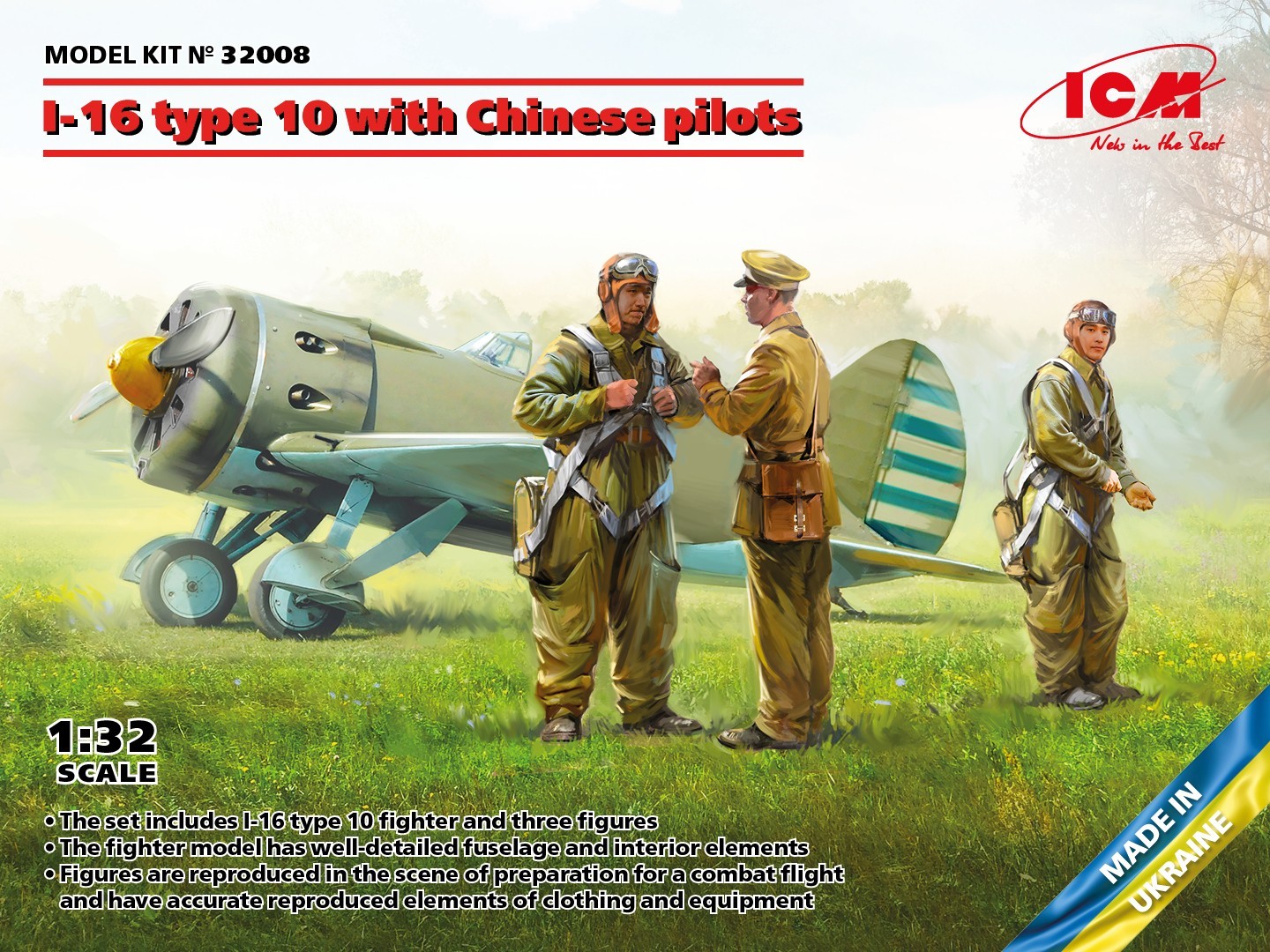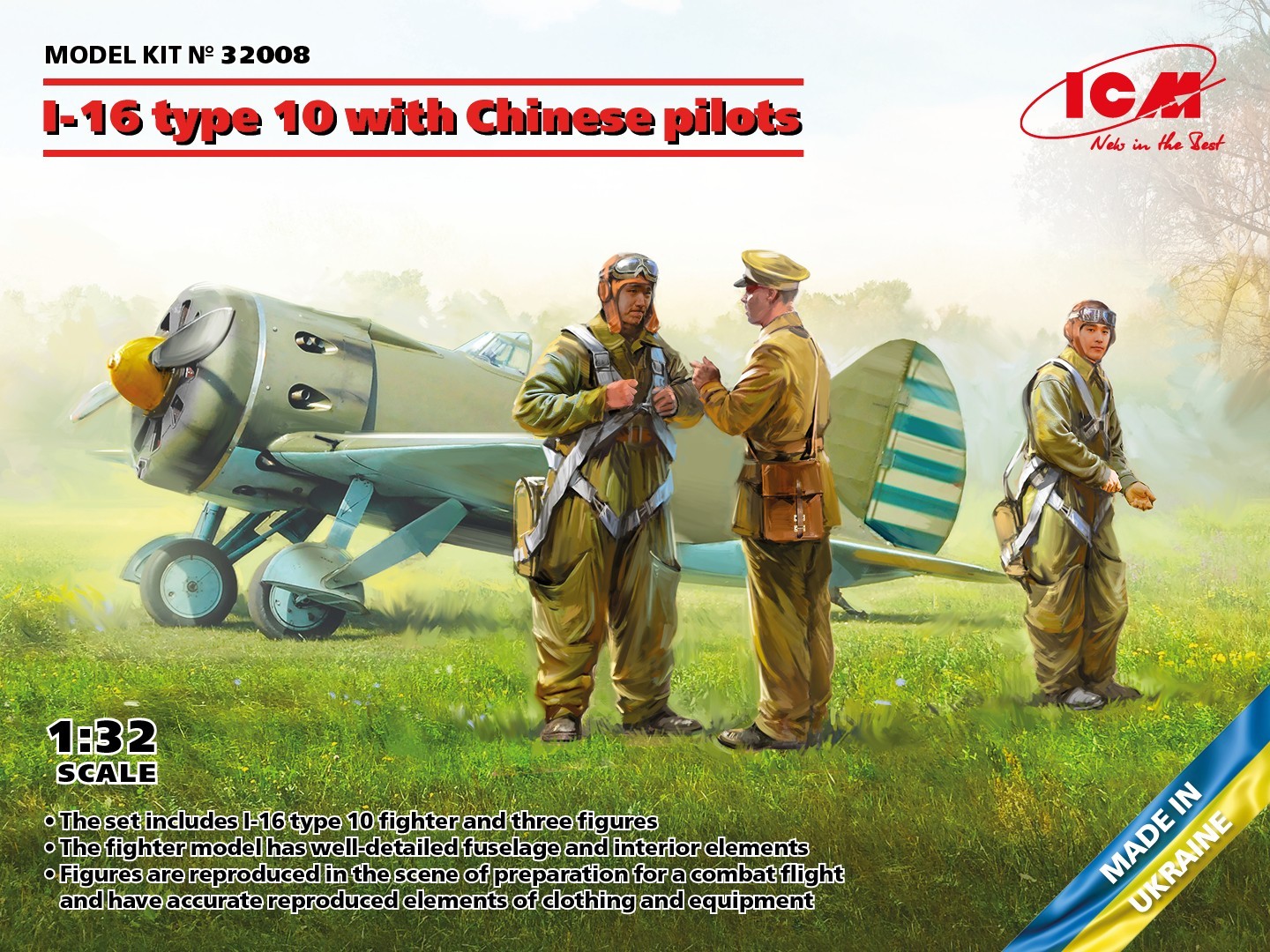
Introduction
There has been a number of 1/32nd scale aircraft released by ICM recently with the Polikarpov I-16 proving a popular aircraft in the scale. ICM has tackled the Polikarpov I-16 as the type 10 version which has required the addition of some large new mouldings. The Polikarpov I-16 type 10 saw service in the Spanish Civil War, Khalhin-Gol conflict and of course World War 2.
The I-16 flew during the Spanish civil war on the Republican side and after the Civil War flew on with the Nationalists after the war ended; this small aircraft was also flown by both Russia and China against the Japanese and also managed some victories there until the Japanese worked out how to defeat it. The aircraft flew during the early stages of World War 2 until more capable aircraft designs relegated the I-16 to the backup role away from the front line. Regardless of it being out classed by World War 2 this aircraft design represents the end of the road for the biplane and the birth of a whole new series of fighters.
Review
This offering from ICM is packaged in their now standard high quality cardboard flip top tray and separate card lid. This packaging will hold up to everything but the roughest treatment by postal services. Inside there is a re-sealable plastic bag containing four grey sprue for the aircraft plus a clear sprue in its own bag. There is an instruction booklet for the aircraft and the decals for the model are also packed inside the booklet. A look at the sprues indicates that the moulds are holding up very well and of the standard I expect from ICM.
Starting with the cockpit on this offering and while it is limited in detail for a 1/32nd scale model I feel there is enough detail present due to the very small amount that can be seen trough the cockpit opening. The one weakness that has been shouting out at me with every release of the I-16 is the lack of harness detail, a detail that is possibly the only one you really see; Eduard has released a set of seat harnesses for this aircraft but not specifically for this model. The instrument panel has been tackled in an interesting manner with a decal that should be placed on rear of a clear moulding and then inserted into a grey moulded part; the result is a dial that looks to have depth and a clear lens. Another positive with this area of the model is that a lot of bulkheads are provided and so make getting the fuselage aligned and so go together correctly. I also like that a full cockpit floor has been replicated rather than a just a portion.
The fuselage of the model has been well tackled having a good level of detail moulded on the interior where the cockpit is situate and the ribs in the tail are clearly visible; I don’t know if the tail was a fabric skin for this detail to be so prominent. I do know from past experience that the internal bulkheads are the only thing holding the aircraft fuselage in place after its put together. The right half or the fuselage on this model is a new part as the large access panel in later versions is incorrect for the type 10. The rudder is shown as workable and so not glued in place I would suggest it is cemented at the angle you prefer. You will notice that there is not a lot in the way of panel lines visible on the fuselage and that does seem to be correct looking at photographs of the real aircraft. Please not that when part 21 is added to the front of the fuselage the seams should be filled as only the machine gun mounts have a visible seam. The front engine cowl and lower area in front of the wings has been changed due to the change in engine; I cannot tell you if the engine looks different, but it was a lower powered engine in this version of the I-16.
The wings and tail of the I-16 type 10 would seem to show a lot of ribbing through the covering looking at online reference; I am unsure if this is due to the images being of aircraft that are still around or an aspect of the aircraft in use. Looking for period photographs proved fruitless as regards showing that detail well, but my gut instinct tells me the leading edge should be smooth. The control surfaces on both the wings and tail are provided separately and so can be set at the angle the modeller prefers. The detail on the upper face of the wings near the root is another area that I was unable to verify how accurate the detail provided is. The entire lower wing is a new part and does away with the rocket mounts and changes the wheel bays detail.
This offering from ICM provides quite a nice representation of the radial engine with the exhausts being the only aspect you will see once the model is built. There are three panels that you could leave off the model to display the engine, but if you decide to take that route you will need to put a lot of effort into further dressing up the engine. With this in mind I did a little looking and thanks to this model having been originally released in 2017 there are a number of aftermarket companies offering upgrades for the modeller. Another aspect that I am happy to see included is the machine guns mounted above the engine. The lower exhausts are new parts in this offering. ICM has provided a new profiled propeller for this offering along with a new nose cone, the nose cone is more pointed than in later examples where it is domed.
The canopy for the I-16 only consists of the front screen; the I-16 was supplied with a fully enclosed cockpit but due to issues with it sticking pilots had it removed and so a front screen only is correct. The detail present in the canopy looks correct to me and is of a reasonable thickness.
The undercarriage is an area I have got a little upset about in the past due to the tail wheel being a single moulding rather than the wheel being a separate part from the leg; not so in this case as the type 10 did not have a tail wheel but instead has a skid. The main undercarriage was raised and lowered manually by the pilot using a winch inside the cockpit and that is why there is a hole in the middle of the wheel bay. A thin wire needs to be placed from the centre of the wheel through the hole in the wheel bay and this detail can be seen in the attached videos. I will say that I struggled with the undercarriage on one of the I-16 models in this scale and so take your time to get this right and avoid the struggles I had. The modeller will need to do some work on the undercarriage legs as the brake lines are missing and it is a little simplified in my opinion. The new wheel wells have a oval opening that remain open and are there for the pilot to verify if the undercarriage is fully up or down.
ICM has provided four finishing options with this model and I am impressed with the decals despite there being quite a lot of carrier film around the number decals. The colour is good and so far as I can see there is no bleeding present. The aspect that pleases me the most is that when running a finger over the decals I cannot feel the decals on the carrier paper. The four finishing options are:
I-16 type 10, China Guomindang AF, 1939
I-16 type 10, 23rd Chantay (Squadron) of China Guomindang AF, 1939
I-16 type 10, 24th Chantay (Squadron) of China Guomindang AF, September 1940
I-16 type 10, 24th Chantay (Squadron) of China Guomindang AF, June 1941
Figures
The figures in this release provide two pilots and an officer and so are suitable for a diorama or vignette. All of the figures are stood upright and the moulding quality is very good offering clean parts. The pilots are wearing a very baggy set of coveralls with thigh pockets and a non-descript leather flying helmet with goggles. The parachute harness detail is well presented with one of the figures securing or releasing that harness. The officer is wearing tunic and trousers typical of officers the world over in Allied Europe if a little loose for uniform. Hand and facial detail is very nicely done, but I cannot say they are specifically Asian in look but who knows when painted.
Conclusion
The combination of figures and aircraft in the scale is something that ICM does well in most regards, but please think about the harness detail in the cockpit. The finishing options are a little dull, but finishes were not a priority for the Chinese during the war. The contents need some effort on the part of the modeller to get a really nice model and at the very the cockpit needs that harness added.

